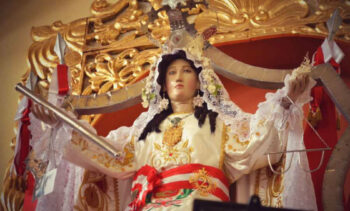Mary, first and perfect disciple

By Fr Patrick Brophy SM
For several years I was the parish priest of La Santisima Trinidad, the principal parish of the town of Sullana, in Northern Peru. The central church could seat around 650 people. Hundreds more would attend each of the 8 or 9 Saturday vigils or Sunday Masses. The church had 10 or so different statues of Mary on niches on the side walls of the church. These were all distinct advocations of Mary. Under each was a collection box for the faithful to deposit their offerings. They would say a prayer for the intercession of their favourite ‘version’ of Mary and deposit an offering. I noticed that the church didn’t have a statue of Nuestra Senõra de la Mercedes de Paita – Our Lady of Mercy of Paita, the Patron Saint of the archdiocese of which the parish was part. One day one of the faithful donated this very statue. So, I installed her in one of the niches. To make room for this new statue, I relegated Our Lady, Help of Christians to a meeting room. I thought I was on safe ground – the collection box beneath Mary Help of Christians was almost invariably empty, indicating there weren’t too many of her devotees in the parish.
That very Sunday I was accosted by a Salesian sister of John Bosco demanding to know where ‘her’ Mary was. Sister was visiting from Lima and had visited the church just after I’d retired Our Lady, Help of Christians. I hastily explained that she was merely on holiday. So we instituted a plan of rotation of our statues of Mary so as not to offend anyone.
Interestingly Our Lady of Mercy of Paita bears a scar on her neck – she was attacked by the English buccaneer George Anson in 1742. As he sacked the town of Paita he tried to behead Mary’s statue with his sword “in a fit of Protestant pique” as a guidebook recounts. Our Lady of Mercy of Paita bears a sword mark on her throat.
When I was a kid, I was not fond of saying the Rosary. Every evening we would get down on our knees and would say the family Rosary. Mum or Dad would lead the rosary, with each of us, when we were old enough, saying a decade; an Our Father and ten Hail Mary’s. We kids used to squabble a lot and Mum would have to sort us out. Anyway, the advent of television news at 5.30pm saved us kids from this nightly ‘torture’.
And yet it is perhaps, a sign of the efficacy of Mary’s intercession, and probably a huge grace of the Rosary, that I ended up becoming a Marist – a member of Mary’s Society. Lucky for me, Fr Colin, the founder of the Society of Mary always maintained that Marists are not characterised by a particular devotion or advocation of Mary. We don’t emphasise Our Lady Help of Christians (Salesians), or Our Lady of Mt Carmel (Carmelites), or Our Lady of Mercy (Mercedarians), or Our Lady of Guadalupe (Missionaries of the Holy Spirit) etc. Rather Marists are called to imitate Mary. Long before the ‘What Would Jesus Do (WWJD)’ slogan seen on bumper stickers and wristbands, Marists were encouraged to “think, judge, feel and act” as Mary did in her discipleship of her Son, Jesus.

Nuestra Señora de las Mercedes of Paita - La Mechita -
Patron Saint of the Port of Paita, Northern Peru
Marists bear Mary’s name. Fr Colin always thought of the Society of Mary as open to everybody – his image for the Society was of a tree of many branches: priests, sisters, brothers, lay folk. In this issue in the month of Mary, we present some articles that might interest those who wish to be a part of Mary’s family, to deepen their understanding of what it means to be Marist. Fr David Kennerley SM begins a series that will help us to reflect on these issues. Other articles will challenge us to broaden our vision of Mary, the mother of Jesus and her place in our lives. Pope Francis will invite us to reflect on two ways we can look at Mary. We don’t have to pray the rosary or any of the other Marian devotions. Perhaps the best devotion is to imitate her, the first and pre-eminent disciple of her Son, Jesus.
 Entries(RSS)
Entries(RSS)